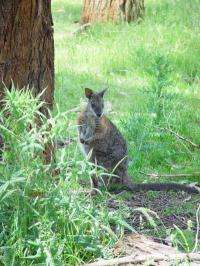Selective imprinting: How the wallaby controls growth of its young

Marsupial mothers regulate the composition of their milk so that it is optimal for the development stage of their young. New research published in BioMed Central's open access journal Epigenetics & Chromatin shows that, similar to the human placenta, which regulates embryonic growth and development, insulin appears to be imprinted in the marsupial mammary gland.
Insulin is well known as the hormone which regulates blood sugar levels but it also essential for proper functioning of the nervous system, protein synthesis, and for cell growth and survival. It is also required for lactation in mammals and, along with insulin growth factor 2 (IGF2), is present in milk.
Imprinting is a way of controlling gene expression. To ensure only one copy of a certain gene is active (monoallelic), the other copy is silenced, usually by methylation. Imprinting is established during sperm or egg production so that the developing embryo inherits paternally imprinted genes from its father, and maternally imprinted from its mother. Consequently the active copy is inherited only from either the mother or father. However this is complicated by imprinting being both tissue specific and dependent on the stage of development.
Insulin was thought to be only imprinted in the yolk sac of mice, and only in the wallaby yolk sac placenta, however, in marsupials much of this growth and development occurs after birth and is controlled instead by milk that changes composition throughout lactation. The University of Melbourne looked at whether the gene wallaby mammary gland is similarly imprinted, if it was also imprinted in the pouch young (joey), and whether this imprinting was maternally or paternally inherited.
The team found that insulin gene (INS) expression in the adult tammar wallaby mammary gland was monoallelic (one active copy), indicating imprinting and that this active copy came from the father. Paternally inherited monoallelic INS expression was also discovered in both the adult and the young tammar liver, but not in other tissues tested. IGF2 was also monoallelic in the mammary gland but the relative expression of INS and IGF2 differed during lactation. IGF2 expression in the mammary gland decreased after the first few days but INS expression increased as the babies became more mature especially between 5 and 14 weeks of age.
Prof Marilyn Renfree, who led this project commented, "This is the first indication that genomic imprinting occurs in the marsupial mammary gland and suggests that genomic imprinting in the mammary gland may be as critical for regulating post-natal growth as it is for regulating pre-natal growth in the placenta in all mammals."
More information: Selected imprinting of INS in the marsupial Jessica M Stringer, Shunsuke Suzuki, Andrew J Pask, Geoff Shaw and Marilyn B Renfree Epigenetics & Chromatin (in press)
Provided by BioMed Central










.jpg)





